Introduction – What Is The Average Tesla Car Battery Life?
The short official answer is 8 years or 150,000 miles, which ever comes first. The long answer is that you’ll likely get more than 8 years out of the Tesla than that.
In fact, in one big study we cover below a Tesla battery seems to degrade only 7% over 220,000 miles of use. Similarly, in a second big study degradation of only 7% happens over 8 years of driving.
This implies the car will last 24 years before the battery degrades to 80%. To understand why, read on.
In this post, we will find out the Tesla’s battery life, explore the different factors that affect it and offer some tips for making your battery last longer.
We draw from a third party researcher source, Elon Musk’s tweets, a study released by Tesla and a study by NimbleFins using survey data. Arguably the first and fourth are the most objective and we spend the most time on it.
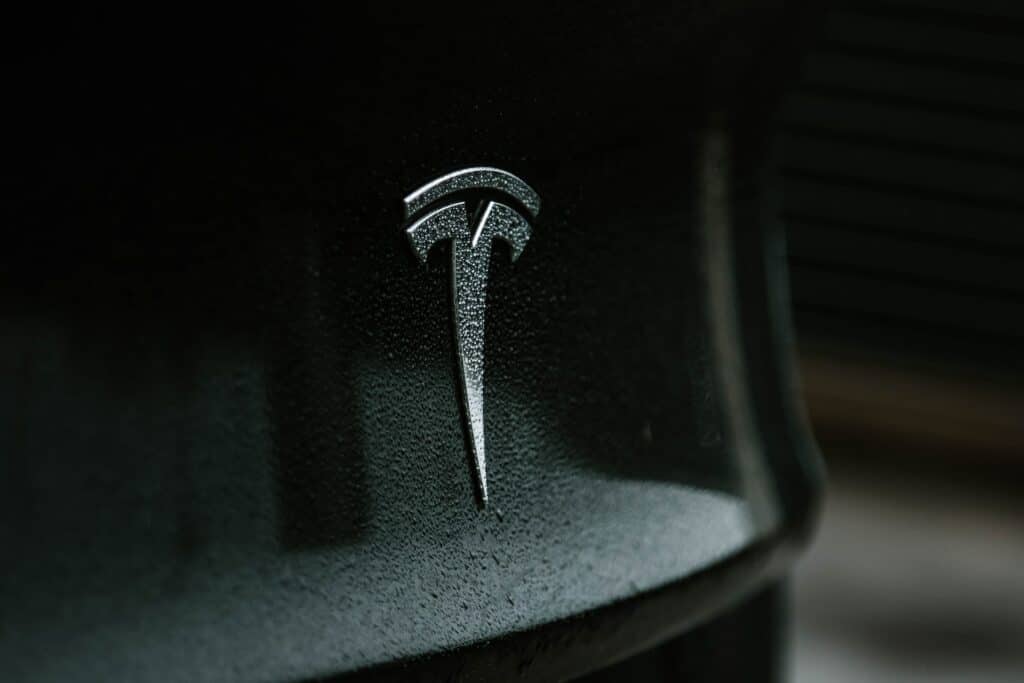
1. Tesla Battery Life: Real World Data Suggest 300,000 Miles
Maarten Steinbuch and Merijn Coumans at the Eindhoven University of Technology in the Netherlands analyzed data from about 500 Teslas.
The 2018 study is one of the most cited resources regarding Tesla battery degradation. The researchers gathered data from 500 Tesla vehicles over a period of time, and the vehicles had driven various amounts of mileage.
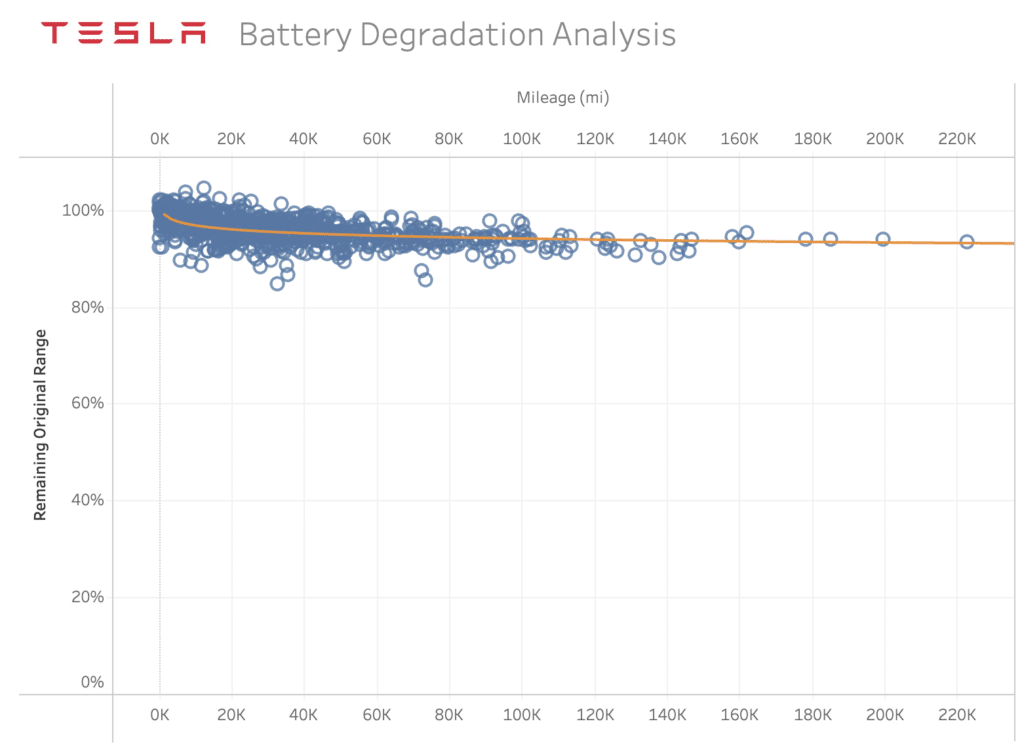
Tesla batteries degrade to 93% of their original capacity after driving 220,000 miles (or approximately 354,000 kilometers), it suggests that, on average, a 7% degradation occurs at this mileage.
This doesn’t mean every Tesla will see exactly this amount of degradation at exactly this mileage. Some may see more, some less, due to factors such as how the vehicle is used, the climate it operates in, how it is charged, and so on. It’s an average figure across a large sample of vehicles.
A 7% degradation after 220,000 miles is quite impressive, reflecting the longevity and durability of Tesla’s electric vehicle batteries. As a comparison point, typical lithium-ion batteries may degrade by about 20% after 1000 full charge-discharge cycles.
Given that a full charge might last for about 300-400 miles in a Tesla, this could suggest around 20% degradation after 300,000-400,000 miles — though real-world conditions are more complex and this is a very rough estimate.
2. Tesla Battery Life: Officially Guaranteed 150,000 Miles Or Unofficially Guaranteed 300,000-500,000 Miles
Once Elon Musk, the CEO of Tesla, reported unofficially via Twitter that a Model 3 battery should last 300K to 500K miles.
However, Tesla officially guarantees that the battery will last either 8 years or 150,000 miles or 240,000 km.
The guarantee technically means that by the end of that period (time or mileage) the battery capacity retention will remain above 70%.
We also did a calculation for you below to see which one would come first. The average passenger vehicle according to the FHTSA accumulates 9000 miles per year. That includes commuting and road trips.
For the average passenger car, the travel per year range is 11,000 miles, according to the FHTSA statistics (somewhat outdated).
This translates to an average number of charge-discharge cycles which is equivalent to 88,000 miles for 8 years of average range of 11,000 miles.
The Tesla guarantee of 150,000 miles for the battery life put another way is an upper limit on the number on charge-discharge cycles for the battery before it degrades to the 70% capacity.
For each model that is different because of the range capacity of the battery.
According to our table below, it means on average, in 8 years, you will be nowhere close to the charge-discharge limit that takes the battery to 70% capacity.
In fact, if we assume average mileage per year of 9000 miles as above, we expect a car to take 13 years to reach 150,000 miles.
Looking at the figures below, the Model 3 comes closest to having the most charge-discharge cycles on the battery due to its lower range compared to all the other models.
For all models, the average charge-discharge cycles is far below the limit given by the guaranteed number of cycles. This means most people’s Tesla cars will be nowhere near the cycle limit.
| Tesla Model | Range | Guaranteed Charge-Discharge Cycles (150,000 miles) | Average Charge-Discharge Cycles (8 Yr Mileage) |
| Model 3 | 267 miles | 562 | 330 |
| Model 3 Long Range | 334 miles | 449 | 263 |
| Model 3 Performance | 315 miles | 476 | 279 |
| Model S | 405 miles | 370 | 217 |
| Model S Plaid | 396 miles | 379 | 222 |
| Model X | 351 miles | 427 | 251 |
| Model X Plaid | 335 miles | 448 | 263 |
| Model Y Long Range | 318 miles | 472 | 277 |
| Model Y Performance | 303 miles | 495 | 290 |
So there you have it. The official guarantee is 150,000 miles or 8 years. It’s quite hard for the average driver to hit 150,000 miles.
It should take 13 years for the average driver. On the other hand, after 8 years Tesla no longer guarantees the battery to be able to charge up to more than 70% capacity.
The truth is that the battery will likely last after the 8 years according to driver reports.
3. Tesla’s 2022 Report On Battery Life – 12% Degradation At 200,000 Miles
Finally, in a 2022 report from Tesla.com, it is reported that the battery degradation in Tesla vehicles is only 12% even after 200,000 miles of use.
The report states that there is no need for battery replacement in Tesla electric vehicles (EVs), supported by over a decade’s worth of reliable data reflecting battery degradation over time.
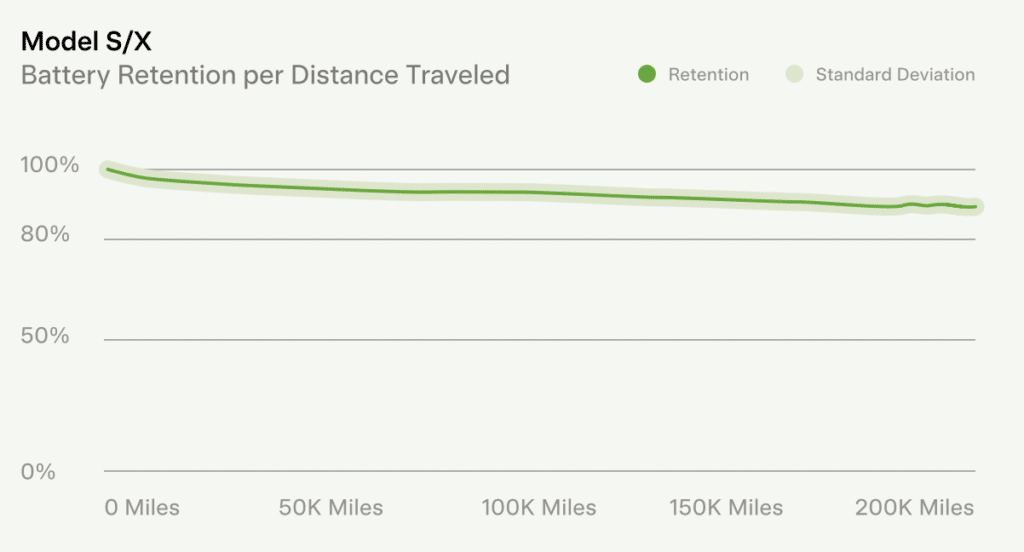
The report estimates that, typically, a vehicle in the U.S. is scrapped after approximately 200,000 miles of usage and roughly 150,000 miles in Europe.
Even after this considerable mileage, the average Tesla battery only loses about 12% of its original capacity.
Interestingly if you compare the Tesla internal study to the external study (in number 1) above, the internal study is showing the battery performs worse with greater degradation (12%) at 200,000 miles compared to the external study (7%).
4. NimbleFins Study: Real-Life Tesla Battery Deterioration

A newer study from NimbleFins in 2022 focused on the real-life battery deterioration of Tesla Model S vehicles. The study spanned from 2013 to 2022 and sourced its data from Plug In America, involving over 624 cars covering 26,669,758 miles.
The study found that an average 7-year-old Tesla battery still provides around 93% of its original capacity. It also estimated that a typical Tesla battery will last more than 10 years, with 10-year-old batteries still delivering around 80% of the original range. Battery replacement costs in the UK were also discussed, starting from £8,000 plus labor.
The data for this study was sourced from Plug In America, which conducted a survey involving 624 Tesla Model S vehicles. The survey covered over 26 million miles, providing a substantial dataset for analysis. The average mileage per year per vehicle was reported to be 15,780 miles.
Battery Degradation
The study found that Tesla batteries generally hold up well over time. A 7-year-old Tesla battery was found to still provide around 93% of its original capacity. The study also estimated that a 10-year-old Tesla battery would still offer around 80% of the original range.
Longevity and Replacement Costs
NimbleFins estimates that a typical Tesla battery will last more than 10 years. The study also discussed the financial aspect of owning a Tesla, particularly the cost of battery replacement in the UK, which starts from £8,000 plus labor.
5. Fast Charging Does Not Affect Battery Life

In 2023, a significant study by Recurrent examined the impact of fast charging on over 12,500 Tesla vehicles in the U.S. This research aimed to determine whether the software and safety mechanisms within the battery management system (BMS) effectively prevent damage during fast charging.
The study compared Tesla vehicles that fast-charged at least 90% of the time with those that did so less than 10% of the time. The findings were reassuring: there was no statistically significant difference in range degradation between the two groups.
This suggests that the robust thermal, voltage, and battery management systems in electric vehicles, including Teslas, are effective in protecting batteries from damage with routine fast charger use. These insights are expected to apply across various Tesla models and potentially to other EV manufacturers, although further detailed research is ongoing.
Factors Affecting Tesla Car Battery Life
Tesla car batteries are designed to last for the lifetime of the car, but several factors can affect their lifespan. Here are some:
1. Climate of location – hotter means faster degradation
If you live in a hot climate, your Tesla car battery will heat up more often and will degrade faster than if you live in a cool climate. The ideal temperature for a Tesla car battery is between 20-25 degrees Celsius.
2. Number of charges and discharges – more cycles reduce the efficiency of the car
The Tesla automobile battery gradually declines with each charge and discharge.
Therefore, the battery life of your automobile will be prolonged if you only charge it when it is nearly empty, or if you only use it for lengthy trips and never let the battery run down completely.
3. Driving habits – good habits include reducing speed and braking
Battery life in a Tesla vehicle is maximized with gentle, moderate driving. Driving at high speeds frequently and with harsh braking and acceleration will shorten the battery’s lifespan.
The car’s mileage and performance will degrade over time as a result of this. Though it’s tempting to test the limits of your Tesla, doing so will reduce its longevity in the long run.
4. Exposure to sunlight – like heat, sunlight will cause the battery to degrade faster
If your Tesla car is parked in direct sunlight for extended periods, the battery will heat up and degrade faster than if it’s kept in the shade or garage.
Hot weather can cause your battery to degrade faster, so it’s important to keep it cool when possible.
When parked in direct sunlight, use a sun shade to protect your car’s interior from excessive heat.
5. Age – older batteries hold less useable energy
Like all batteries, a Tesla car battery will undergo electric car battery degradation with age even if it’s not used frequently or exposed to extreme temperatures.
However, the degradation process can be slowed down by following the tips above.
Tips For Making Your Tesla Car Battery Last Longer
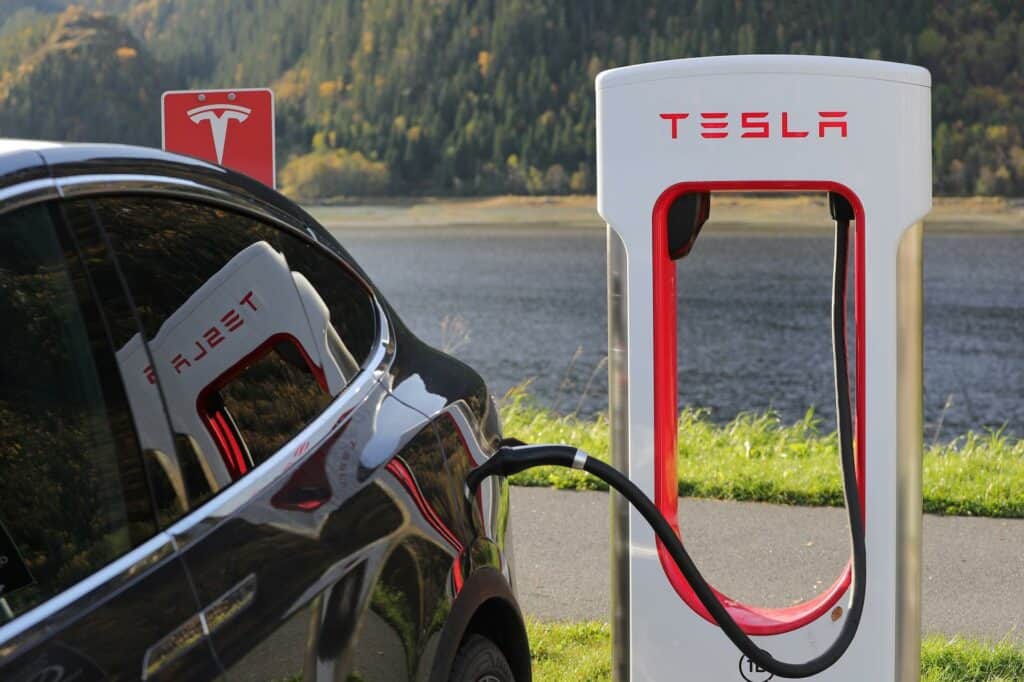
As a Tesla car owner, you understand the significance of the battery. Whereas internal combustion engine cars suffer from large moving parts which break down under extreme temperatures and heat during the course of a car’s lifetime of operations, Tesla’s are “engine-less” in that the motor’s motion directly drives the wheels so the lifespan is largely limited by the number of useful charge-recharge cycles. A Tesla battery, if maintained correctly, has a long lifespan. Here are some tips to help you get the most out of your battery:
1. Keep Your Battery Charged
One of the best ways to prolong battery life is to keep it charged. When your battery gets low, it puts strain on the charging system, which can shorten its lifespan. Try to keep your battery above 20 percent charge whenever possible.
2. Always Maintain A Clean Battery In Your Tesla Vehicle
Like any car battery, it’s important to keep your Tesla battery clean to prevent corrosion. Use a soft cloth or brush to gently remove any dirt or debris that has accumulated on the terminals.
3. Don’t Leave Your Tesla Parked For Too Long
If you know you’ll be leaving your Tesla car inactive for a while, it’s best to disconnect the battery. This will help to prevent it from draining unnecessarily.
- To do this, open the hood and locate the negative battery terminal. Then, using a wrench, loosen the nut that secures the cable to the terminal.
- Carefully remove the cable from the terminal, and make sure that it doesn’t come into contact with any other metal surfaces.
- Once the battery is disconnected, cover the terminal with a heavy-duty plastic bag to insulate it and prevent accidental shorts.
- Finally, close the hood and store the key fob in a safe location.
4. Get Regular Service
Just like any other car component, batteries need regular maintenance to function properly.
Take your car in for service at least once a year so that there will be possible extending car battery life and any potential issues with your battery can be addressed before they cause long-term damage.
Tesla Has Transformed The EV Battery Industry
Tesla has really changed the perception of what are possible with cars.
With features like autopilot, self-parking, and a range of over 200 miles per charge, these cars offer a glimpse into a future where we’re less reliant on internal combustion forms of transportation.
And with Tesla’s commitment to sustainability, their cars are are reducing our impact on the environment.
With this, Tesla cars are known for their clean, green credentials – and a big part of that is thanks to the batteries that power them.
Tesla batteries are made up of many small, cylindrical cells which are grouped to form a single battery pack.
This pack powers the car – and can be recharged by plugging the car into an electric socket. The cells themselves are made from lithium-ion, a type of material that is very good at storing electrical charge.
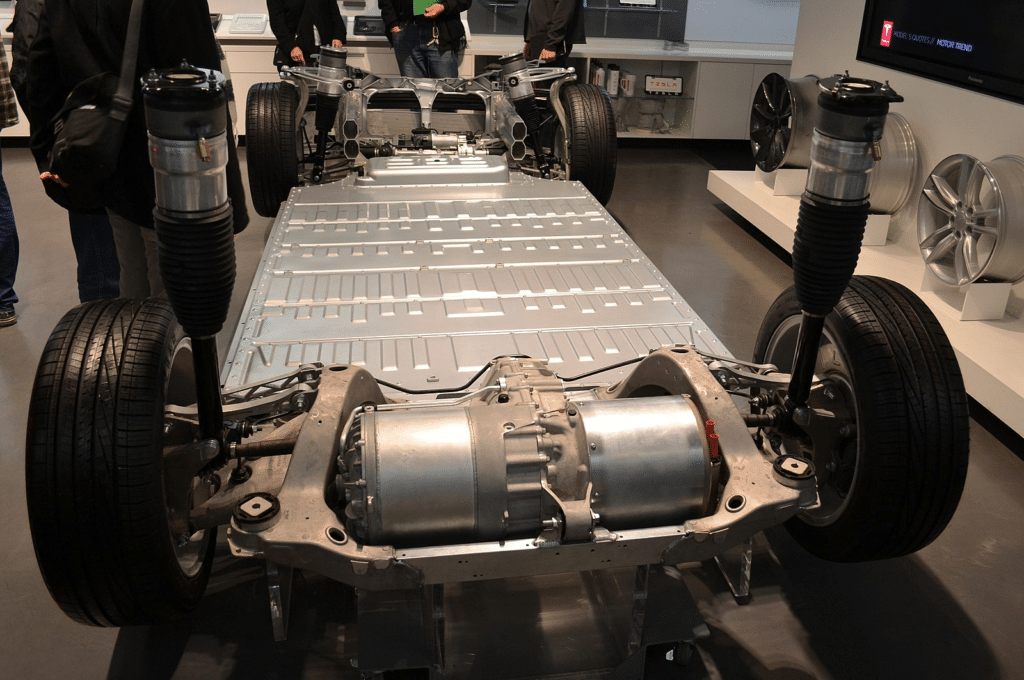
The batteries themselves are not particularly green. The carbon reduction and green friendliness comes from the fact that the battery is powered by the electrical grid.
And the grid, for most places, meaning big chunks of the world, is cleaner than gasoline-burning internal combustion. It comes down to two numbers.
The first is the energy efficiency that describes the Tesla’s ability to travel per amount of energy, that is the kilometer per kilowatt hour or km / kWh; and the second number is emissions efficiency in grams of carbon dioxide emitted per kWh or g CO2 / kWh.
Combining the two gives the amount of carbon dioxide per distance traveled or the g CO2 / km.
For internal combustion cars, this is derived from the emissions of burning gasoline and the fuel efficiency of the car.
We compared this critical number in this article on electric cars vs other cars and find that electric cars are best for the most part except in countries where the grid is heavily reliant on coal or oil.
Telsa Batteries – Expect Improvements From the 4680
Although there’s little data yet, Tesla’s 4680 battery cell is expected to yield a significant development in electric vehicle technology. This innovative cell design, pivotal for Tesla’s future electric vehicles, is believed by many to improve durability and therefore battery lifetime.
As of 2023, Tesla has been producing these cells at its Fremont pilot plant and is gearing up for higher volume production at Gigafactory Texas. The 4680 cell not only sees better manufacturing efficiency but also underpins Tesla’s new structural battery pack design, first seen in the Model Y produced at Gigafactory Texas.
Conclusion
So there you have it. Both the real world reports and the official Tesla announcements consistently put the battery life at about 400,000 miles, which is on average over 20 years of driving for the average American.
As we’ve seen, there are a few different things you can do to get the most out of the battery life of your Tesla vehicle.
You can assist in extending the life of your battery and ensuring that it continues to be in good condition for many years to come if you follow the advice that has been provided above.
Your Tesla vehicle’s battery can provide you with a trouble-free operation for many years if it is properly cared for and maintained.
